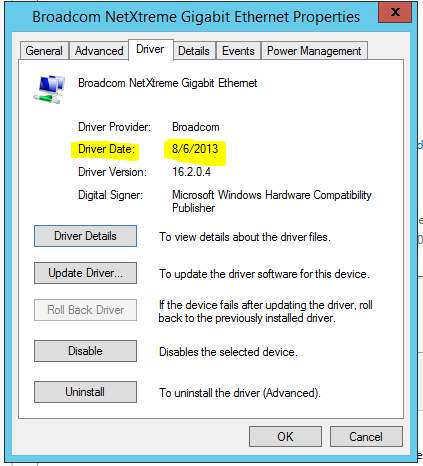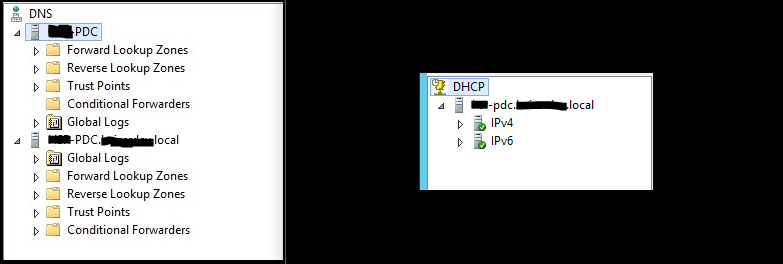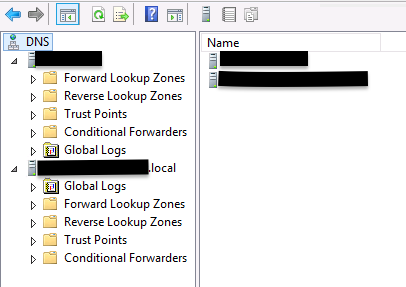In Response to ID: 40786002 (Cliff Galiher) Replacing Broadcom NIC's with Intel
We have a server that fails miserably during updates which has a Broadcom NIC. This is not an unknown issue with Server 2012R2 and the havoc placed on the VM's.
Questions:
1. what Intel NIC do you recommend.
2. any consideration during installation we should be aware of. For example binding in DNS, DHCP, etc.
Thank you.
Questions:
1. what Intel NIC do you recommend.
2. any consideration during installation we should be aware of. For example binding in DNS, DHCP, etc.
Thank you.
What kind of server is it and how is it failing? It could hopefully be resolved by updating the drivers for the NIC. We need a little more info to diagnose the cause of the problem. Adding a new NIC may not fix the issue if something else is causing it.
ASKER
PowerEdge Server T320 with Broadcom NIC Broadcom NetXtreme Gigabit Ethernet
Runs fine until Window updates are applied then the static IP's change on the host and VM's, Outlook will no longer connect to Exchange. Exchange literally comes to a halt its so unresponsive.
DNS obviously doesn't resolve correctly when this happens. It's happened three time now after Window updates were applied. The timing can't be coincidental in my opinion.
Runs fine until Window updates are applied then the static IP's change on the host and VM's, Outlook will no longer connect to Exchange. Exchange literally comes to a halt its so unresponsive.
DNS obviously doesn't resolve correctly when this happens. It's happened three time now after Window updates were applied. The timing can't be coincidental in my opinion.
ASKER
I just disabled VMQ on both adapters according to this article .
I gave bad info, thought drivers were up to date they're apparently not.
NIC configuration Virtual NIC drive (how do I go about locating this driver)
Virtual NIC drive (how do I go about locating this driver)  Broadcom NIC
Broadcom NIC 
I gave bad info, thought drivers were up to date they're apparently not.
NIC configuration
Runs fine until Window updates are applied then the static IP's change on the host and VM's, Outlook will no longer connect to Exchange. Exchange literally comes to a halt its so unresponsive.
HUH? It makes no sense that Windows updates would change the IP address of the host.
Can you please post a complete IPCONFIG /ALL from both the host and the VM?
(I seem to ask this of you a lot -- but it really does help in identifying the problems).
Thanks!
ASKER
No worries, info on the way. It doesn't change it, for example 192.168.1.1 to 192.168.1.2 it changes it from static to dynamic.
ASKER
ipconfig for the host and two VM's, one is the PDC and the other is Exchange.
Host ipconfig_all_host.txt
PDC ipconfig_all_pdc.txt
Exchange ipconfig_all_exchange.txt
Host ipconfig_all_host.txt
PDC ipconfig_all_pdc.txt
Exchange ipconfig_all_exchange.txt
ASKER
@William need any more info?
@TechSoEasy need anything else?
Thank you
@TechSoEasy need anything else?
Thank you
ASKER CERTIFIED SOLUTION
membership
This solution is only available to members.
To access this solution, you must be a member of Experts Exchange.
A couple things stick out to me in your IPCONFIGs -- I'm pretty sure they aren't responsible for your problem, but in any event you should probably address them:
1. On your host -- the Default Gateway is missing the IPv6 entry. All the IPv6 stuff is configured automatically, so I'm wondering how that disappeared. Did someone monkey around with IPv6 settings?
2. Also on the host -- you should disable NIC2 as it's not being used -- better to just have it out of the way -- even though it's not connected to anything.
3. On your PDC -- I doubt you have actually configured an IPv6 DNS Server, so get rid of that ::1 (equivalent to 127.0.0.1) IPv6 DNS Server that is listed. Also, in your DNS Server Settings be sure that binding is set to only be on the IPv4 address.
FYI, the 2006 dated driver for the virtual NIC is the correct one. There is no update for it so don't worry about that.
But here's your icing on the cake -- I did a quick search on the Broadcom nic and found that there is a serious issue with them in virtual machine environments:
https://support.microsoft.com/en-us/kb/2986895
I think you may have somehow associated this with Windows Updates but it probably was a coincidence.
1. On your host -- the Default Gateway is missing the IPv6 entry. All the IPv6 stuff is configured automatically, so I'm wondering how that disappeared. Did someone monkey around with IPv6 settings?
2. Also on the host -- you should disable NIC2 as it's not being used -- better to just have it out of the way -- even though it's not connected to anything.
3. On your PDC -- I doubt you have actually configured an IPv6 DNS Server, so get rid of that ::1 (equivalent to 127.0.0.1) IPv6 DNS Server that is listed. Also, in your DNS Server Settings be sure that binding is set to only be on the IPv4 address.
FYI, the 2006 dated driver for the virtual NIC is the correct one. There is no update for it so don't worry about that.
But here's your icing on the cake -- I did a quick search on the Broadcom nic and found that there is a serious issue with them in virtual machine environments:
https://support.microsoft.com/en-us/kb/2986895
I think you may have somehow associated this with Windows Updates but it probably was a coincidence.
ASKER
@Jeffery looking into your post now. Someone did work on the server for a short bit.
I'ver never seen two DNS servers in a small network like this. What are your thoughts about removing the DNS server that does not correlate with the DHCP server. In other words keep the two that end in .local.
I'ver never seen two DNS servers in a small network like this. What are your thoughts about removing the DNS server that does not correlate with the DHCP server. In other words keep the two that end in .local.
I don't see two DNS Servers. That's not what I said.
What I described is that on the PDC, in the NIC settings, if you open up IPv6 you will see a static IP address listed (::1). Delete that entry and set it to get the information automatically.
Then you need to go into your DNS Server settings on that same machine. Right click the SERVER NAME > Properties and you'll see that it is bound to both IPv4 and IPv6. Make sure that it is only bound to IPv4.
After you do that, restart the server.
Again, the above is just to help your DNS run a bit cleaner -- I do not believe it is the cause of your problem. Most definitely your problem is related to the outdated driver on the Broadcom NIC on your HOST.
What I described is that on the PDC, in the NIC settings, if you open up IPv6 you will see a static IP address listed (::1). Delete that entry and set it to get the information automatically.
Then you need to go into your DNS Server settings on that same machine. Right click the SERVER NAME > Properties and you'll see that it is bound to both IPv4 and IPv6. Make sure that it is only bound to IPv4.
After you do that, restart the server.
Again, the above is just to help your DNS run a bit cleaner -- I do not believe it is the cause of your problem. Most definitely your problem is related to the outdated driver on the Broadcom NIC on your HOST.
Well none of your servers are actually using that second DNS Server so I don't know what the relevance is.
This brings up another question though... because what do you mean by "the two that end in .local"?
This brings up another question though... because what do you mean by "the two that end in .local"?
ASKER
This brings up another question though... because what do you mean by "the two that end in .local"?
which one can I remove. I've never had to remove a DNS server and the one time I had a botched install I ended up creating DNS by hand. It wasn't fun. Not to mention the havoc it created.
I don't know which one... I can't see your environment, and you've only posted just a bit of what you're seeing.
The first thing you have to do is verify if there actually is a second DNS Server running. Just because it's listed in the Windows DNS doesn't mean it is actually there anymore.
The first thing you have to do is verify if there actually is a second DNS Server running. Just because it's listed in the Windows DNS doesn't mean it is actually there anymore.
ASKER
For obvious reasons I'm a little reluctant to delete a DNS server. What I meant about .local is it matches with the DHCP server. Really just an observation. I've never seen this before and am trying to track down how it happened rather than just delete. The old IT was let go because they didn't configure other things correctly, what I refer to as the "mad scientist way". Maybe it's best to focus on troubleshooting.
Which leaves the questions
- which DNS to delete
- which DNS is associated with DHCP. I may have just answered this, I stopped the .local and name resolution stopped (nslookup) failed.
- I'm waiting for the end of business to stop the other DNS server and check nslookup.

Which leaves the questions
- which DNS to delete
- which DNS is associated with DHCP. I may have just answered this, I stopped the .local and name resolution stopped (nslookup) failed.
- I'm waiting for the end of business to stop the other DNS server and check nslookup.
I will ask you again... DO YOU ACTUALLY HAVE TWO DNS SERVERS? or are there just two listed in your DNS Control Panel.
You've blacked out the host names so I cannot tell... but are the host names the same?
ie, XXX-PDC ?
If so, then someone just added the same server a second time in the DNS Control panel -- which is simple to do.
The fact that you are trying to "match" what DHCP has listed is ridiculous....you can call a server by just it's HOSTNAME (NETBIOS NAME) or FQDN (host.domain.local)... but they are still the same damn machine.
REMOVING a Server from your DNS Control Panel does not DELETE the DNS Server. To see what I mean, right click one and select DELETE... it will bring up a dialog box which says, "Do you want to delete the server <servername> from the server list?" You see that's all it is doing -- removing it from a LIST.
You've blacked out the host names so I cannot tell... but are the host names the same?
ie, XXX-PDC ?
If so, then someone just added the same server a second time in the DNS Control panel -- which is simple to do.
The fact that you are trying to "match" what DHCP has listed is ridiculous....you can call a server by just it's HOSTNAME (NETBIOS NAME) or FQDN (host.domain.local)... but they are still the same damn machine.
REMOVING a Server from your DNS Control Panel does not DELETE the DNS Server. To see what I mean, right click one and select DELETE... it will bring up a dialog box which says, "Do you want to delete the server <servername> from the server list?" You see that's all it is doing -- removing it from a LIST.
ASKER
rebuilt PDC, with DHCP and DNS
ASKER
I've requested that this question be closed as follows:
Accepted answer: 0 points for WORKS2011's comment #a41719806
for the following reason:
no solution.
Accepted answer: 0 points for WORKS2011's comment #a41719806
for the following reason:
no solution.
ASKER
Resolved the issue and it was not resolved by updating the NICS.
ASKER
Thank you for the information regarding the NIC's.
